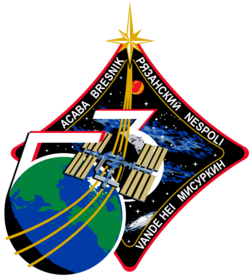Joseph M. Acaba
| Joseph Michael Acaba | |
 | |
| Född | 17 maj 1967 Inglewood, Kalifornien |
|---|---|
| Tid i rymden | 137 dagar, 19 timmar, 22 minuter |
| Urvalsgrupp | Astronautgrupp 19 |
| Uppdrag | STS-119, Sojuz TMA-04M, Expedition 31/32, Sojuz MS-06, Expedition 53/54 |
| Uppdragsemblem | |
Joseph Michael Acaba, född 17 maj 1967 i Inglewood, Kalifornien, är en amerikansk astronaut uttagen i astronautgrupp 19 den 6 maj 2004.
Karriär
BSc i Geologi vid University of California Santa Barbara 1990
MSc i Geologi vid University of Arizona 1992
Rymdfärder
Källor
”Biographical Data” (på engelska) (PDF). NASA. maj 2021. https://www.nasa.gov/wp-content/uploads/2016/01/acaba-jm.pdf?emrc=3a2d87. Läst 9 maj 2024.
|
Media som används på denna webbplats
The Expedition 54 crew insignia
- Orbiting Earth continuously since 1998, the International Space Station (ISS) is one of our greatest engineering achievements. It is depicted in gold, symbolic of constancy and excellence. Flying toward a sunrise represents the station’s contributions to a bright future. That sunrise uses blue, white, and red, the combined national colors of Japan, Russia, and the United States, symbolizing the crew’s cohesiveness. Crewmember names are in blue, symbolizing devotion and loyalty.
- The gold border represents the constant human presence in space onboard the orbiting laboratory. Symbolic of new Russian and U.S. spacecraft that will advance human exploration, the patch is shaped as a capsule. The number 54 is drawn as a path eventually leading to Mars.
- Finally, the stars symbolize the values of leadership, trust, teamwork, and excellence lived by mission control teams throughout the history of human space programs, as well as the global vigilance of those teams while operating the station.
Puerto Rican astronaut portrait joseph acaba
The Expedition 53 crew insignia
- The International Space Station is our launch pad into the future of human space exploration. Collectively, our world stands at the cusp of incredible developments as a spacefaring species. Onboard the space station we continue to evolve the technologies vital to the sustainment and longevity of humans in the harsh realities of living without gravity or the protection of our atmosphere. These self-sustaining or regenerative technologies continually developed aboard the space station not only improve life here on Earth, but they are essential to human beings existence beyond low-Earth orbit (LEO).
- The space station is the linchpin for this next great phase of development and is instrumental in expanding the use of space, not only as a worldclass science laboratory, but also as a destination for next-generation space vehicles. This journey beyond LEO is depicted in the Expedition 53 patch as we, the crew, will endeavor to accomplish the work that allows future missions to further explore our solar system. This journey will only be accomplished as an international team, represented by our multinational crew as well as by the many countries depicted on the globe.
- The myriad of stars represent the untold number of passionate and supremely dedicated people that endeavor across the planet daily to make the space station the amazing vehicle it is as well as prepare us for the next great steps forward in space exploration.
Thin crescents along the horizons of Earth and its moon depict International Space Station (ISS) Expedition 31. The shape of the patch represents a view of our galaxy. The black background symbolizes the research into dark matter, one of the scientific objectives of Expedition 31. At the heart of the patch are Earth, its moon, Mars, and asteroids, the focus of current and future exploration. The ISS is shown in an orbit around Earth, with a collection of stars for the Expedition 30 and 31 crews. The small stars symbolize the visiting vehicles that will dock with the complex during this expedition.
The shape of the STS-119/15A patch comes from the shape of a solar array viewed at an angle. The International Space Station (ISS), which is the destination of the mission, is placed accordingly in the center of the patch just below the gold astronaut symbol. The gold solar array of the ISS highlights the main cargo and task of STS-119/15A -- the installation of the S6 truss segment and deployment of S6's solar arrays, the last to be delivered to the ISS. The surnames of the crew members are denoted on the outer band of the patch. The 17 white stars on the patch represent, in the crew's words, "the enormous sacrifice the crews of Apollo 1, Challenger, and Columbia have given to our space program." The U.S. flag flowing into the space shuttle signifies the support the people of the United States have given our space program over the years, along with pride the U.S. astronauts have in representing the United States on this mission.
This patch represents the 32nd expedition to the International Space Station (ISS) and the significance of the science being conducted there for current and future generations. The arch shape of the patch symbolizes the "doorway" to future space exploration possibilities. The ISS, an orbiting laboratory above the Earth, provides a unique perspective for Earth observation and monitoring. The flame depicts the pursuit of knowledge and highlights the importance of education as the key to future human space flight. The astronaut symbol circles the Earth, acknowledging the work of all astronauts, past, present, and future. The names of each crew member located on the border of the patch are written to honor the various cultures and languages on the mission. The three flags also depict the home countries of the Expedition 32 crew members and signify the collaborative ISS partnership of 15 countries working as one.





